TV and Radio Reception When Touring
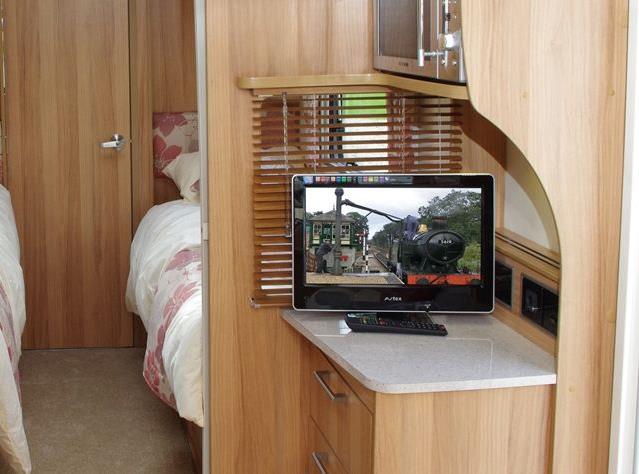
Wherever you are it has never been easier to pick up TV and radio channels from your caravan, motorhome or camping unit. In addition to the terrestrial broadcasts we have enjoyed for more than half a century, we also have the options of satellite broadcasts and tuning in via the internet. Typically a signal antenna and a receiver will be required whether this is via terrestrial aerial or satellite dish and some means of displaying the signal such as a TV, some TV's may have the receiver built-in or a set top box will be required.
Benefit from expert advice, retail discounts and money off pitch night stays when you join the Club.
The key advantage of satellite broadcasts over other means is their coverage in any given country or countries and the sheer number of broadcasts carried. In the UK and Europe these run into the thousands, if you are prepared to point your dish at more than one satellite.
Broadcasts over the internet can be truly global, although geographic restrictions are often applied to comply with broadcasting rights. This means it can be difficult to receive programs in countries other than those for which they were intended. Another consideration is internet speeds and data usage. Streaming video can be extremely data hungry and therefore can be costly.
Terrestrial broadcasts
Traditionally TV and radio signals have been broadcast from networks of ground-based transmitters covering whole countries.
In this Data Sheet there are tips on how best to receive your favourite TV and radio programmes when touring in the UK and abroad. Picking up a good signal depends on having a suitable aerial as well as being within range of the transmitter.
Generally speaking the higher the frequency of a terrestrial signal the more it is likely to be absorbed by obstructions such as buildings and trees. Also the higher the frequency the more information the signal can carry. TV signals in the UK are broadcast at ultra-high frequencies, often requiring a directional aerial to be pointed at the transmitter.
Radio broadcasts on the other hand can be transmitted at much lower frequencies, such as those found in the medium waveband. Here an aerial usually takes the form of a coil wound on a ferrite rod hidden inside the radio. You may need to rotate the radio for best reception but that is all.
Somewhere in the middle lies the VHF (very high frequency) band. This is used for FM and digital radio broadcasts (DAB) and normally requires at least a telescopic aerial for good reception.
Receiving a good TV signal
The leisure industry is well served with TV aerials - most new caravans and motorhomes have had one as standard equipment for many years.
Initially most of these were omnidirectional, meaning they picked up signals equally from all directions and so needed no adjustment. In the days of analogue television this could lead to a ghostly looking picture if the aerial picked up a signal directly and then the same signal was reflected from a nearby object a tiny fraction of a second later.
The gradual switch over to digital television with its better picture quality but initially low transmission power encouraged caravan and motorhome manufacturers to fit directional aerials for their ability to shut out unwanted signals and deliver a better quality signal.
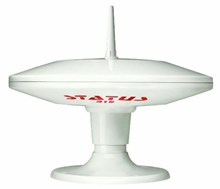
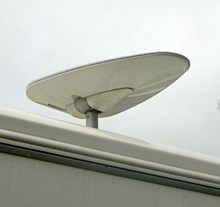

With one of these you not only need to know which direction to aim for but also whether the aerial's elements need to be vertical or horizontal, according to the polarisation of the signal. To help with this the Club has produced a handy guide called TV Aerial Direction and Advice covering the Club Sites (see information panel).
Look at the position and angle of aerials on buildings, other caravans and motorhomes on site and see if you can match them.
Without such a guide you could use one of the many smartphone apps such as Antenna Aligner or Freepoint that indicate where to point the aerial for best reception. Even then the "all or nothing" nature of digital signals is such that a signal strength meter of some form is really the best way to get a good signal.
If you are in a strong signal area you may get away with an indoor aerial but these tend to be ineffective inside caravans and motorhomes with aluminium sides, as the aluminium blocks the signal.
One of the issues with terrestrial TV when touring is the need to retune your TV as you move from one area to another. This is because adjacent transmitters use different frequencies so as not to interfere with each other.
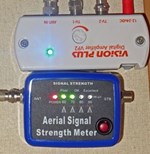
Retuning is not a big issue with modern TVs as most will find and store stations automatically, but only once you have found the menu item that tells them to do so.
Digital transmissions can carry lots of signals on a single frequency. The process that makes this possible is known as multiplexing or muxing and the resulting signal is referred to as a MUX. The signal can include multiple TV and radio channels, text services and electronic programme guide information.
The full Freeview service in the UK uses six multiplexes. Three of these are designated for Public Service Broadcasts (PSB) and include the main BBC and ITV channels. The remaining three are designated Commercial (COM) and carry all the other channels.
In addition to the primary transmitting masts, there are a large number of smaller ones, known as relay stations, designed to provide cover in those areas where the primary masts do not reach, perhaps because of terrain issues.
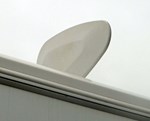 While the primary transmitters carry all six multiplexes by default, it is up to the operators of the relay transmitters to decide which, if any, of the relay stations will do so. So far none has done so.
While the primary transmitters carry all six multiplexes by default, it is up to the operators of the relay transmitters to decide which, if any, of the relay stations will do so. So far none has done so.
Another interesting point about relay stations is that the signals from them are normally vertically polarised to avoid interference with the primary transmitters, which usually have horizontal polarisation.
Satellite broadcasts
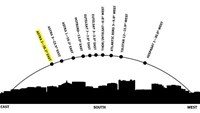 Satellite-based broadcasts have revolutionised TV and radio reception by making it available throughout the UK. To pack in the huge amount of data needed to make satellite broadcasting worthwhile, extremely high frequencies are used, typically in the range 10,000 to 13,000 MHz. Reception requires a suitable dish, equipped with a Low-Noise Block downconverter (LNB) and pointed accurately at the satellite.
Satellite-based broadcasts have revolutionised TV and radio reception by making it available throughout the UK. To pack in the huge amount of data needed to make satellite broadcasting worthwhile, extremely high frequencies are used, typically in the range 10,000 to 13,000 MHz. Reception requires a suitable dish, equipped with a Low-Noise Block downconverter (LNB) and pointed accurately at the satellite.
At these frequencies the radio signal behaves as a beam of light. If anything solid such as a tree or building gets in the line of sight between the receiving dish and the satellite the dish will not be able to "see" the signal. Heavy rain or very thick cloud can also weaken the signal to the point where reception may not be possible.
 Changes made in February 2014 have meant that the main UK channels now have a slightly stronger and more even signal over the UK and Ireland. This is good news for those who like to travel to the far corners of the British Isles as a 45cm dish is now sufficient wherever you are. Another advantage is that smaller dishes are easier to aim. Large dishes tend to be very direction sensitive, a movement of half a degree being enough to lose the signal.
Changes made in February 2014 have meant that the main UK channels now have a slightly stronger and more even signal over the UK and Ireland. This is good news for those who like to travel to the far corners of the British Isles as a 45cm dish is now sufficient wherever you are. Another advantage is that smaller dishes are easier to aim. Large dishes tend to be very direction sensitive, a movement of half a degree being enough to lose the signal.
Types of dish
Manually operated - table/tripod or roof mount
The simplest and cheapest dishes are manually operated. Table and tripod-mounted dishes are light and easy to move around for best reception.
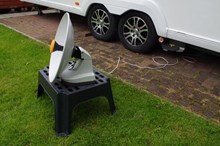
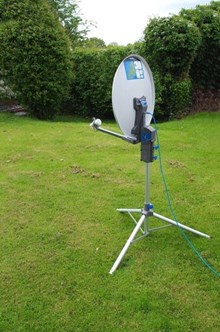
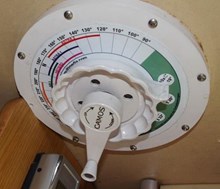
With a manual dish some form of satellite finding device will prove very useful, if n ot essential. Smartphone apps such as DishPointer can give you a good idea of where to aim as well as helping to establish if any obstacles might be obscuring the line of sight.
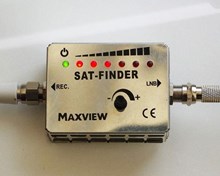 The simplest finders contain a row of LEDs to show the strength of the signal being received. The more lit, the stronger the signal. There may also be a sounder that increases in pitch as a signal is found. This is useful as you do not have to keep looking at the finder but the noise may just disturb a nearby neighbour.
The simplest finders contain a row of LEDs to show the strength of the signal being received. The more lit, the stronger the signal. There may also be a sounder that increases in pitch as a signal is found. This is useful as you do not have to keep looking at the finder but the noise may just disturb a nearby neighbour.
The one problem with this type of device is that it does not tell you which satellite it has found. If you get the wrong one you probably will not be able to pick up anything as the receiver will not be tuned for that satellite. A common mistake is to confuse Astra 1 as 19.2 degrees east with Astra 2 at 28.2 degrees east. When this happens, moving the dish to the left and down a bit usually does the trick.
Spend a little more and you will get something like Horizon's NanoSat. You tell it which satellite you want and it tells you which way to move the dish and gives you an indication of how close you are.
Self-seeking
A self-seeking dish is perhaps the ultimate luxury, although expensive at around £2,000. Most are designed for roof mounting although tripod types are available. The satellites are located in a belt some 22,236 miles above the equator. This means they orbit once per day, making them appear stationary when seen from earth. Viewed from the northern hemisphere, the satellites form an arc in the southern sky with the highest point due south.
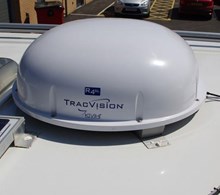

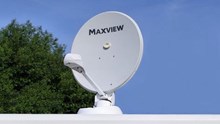
Satellite receivers
It is becoming increasingly common for TVs aimed at the leisure market to have a satellite receiver built in but there are plenty of set-top-box receivers for use with those without. They fall into three basic categories - free to air, Freesat and Sky.
Some free-to-air boxes can be quite complicated to set up so, if you think this may be a problem for you, go for a Freesat-based box. You will get all the main UK channels in a user-friendly package but other free-to-air channels may not be so easy to pick up.
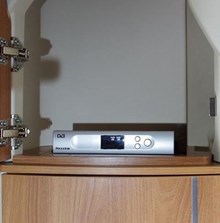
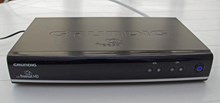
TV and radio via the internet
Thousands of TV and radio stations now stream their output on the internet but broadcast rights issues may restrict access to certain countries. If you will not be going outside the UK and are only interested in UK broadcasts this will not be a problem.
However the downside to watching video content over the internet is the relatively fast connection speeds and high data usage required. For example standard definition (SD) video requires about 2-3 Mbps and will consume around 2GB of your data allowance per hour.
If you do not have a smart TV you can purchase streamers that will plug in to an HDMI socket on your TV and connect a wireless router to access the internet. You can then stream video using your phone, tablet, laptop or a dedicated remote. Some come with inbuilt apps such as iPlayer, Netflix, Sky Now and YouTube.
The relatively small amount of data required for a digital radio signal means you do not need a fast internet connection so reception on most WiFi-equipped campsites should not be a problem. For example listening to a station broadcasting at 128kbps will consume around 55MB per hour. As an alternative to listening via a PC or tablet you can purchase a WiFi radio that will do the job for you.
Making the most of your reception
For the best TV reception it pays to invest in good quality cable and connectors and keep the number of connectors to a minimum. This is particularly important with satellite TV where each connector can lead to a small attenuation in the signal.
Reception from terrestrial aerials can be greatly improved using a signal booster. These work from a 12V supply and use only a very small amount of current, typically 50mA. A signal booster may also allow you to feed more than one TV at once.
It is possible to buy signal boosters for satellite reception but they tend not to improve the quality of the signal, just its strength.
Instead the answer is to invest in a top quality LNB, having a signal to noise ratio of 0.2dB or less.
If you are struggling to receive a good WiFi signal, boosters can again help. These plug into a USB port on your computer and take the place of any internal WiFi adapter that might be present.
Receiving English broadcasts while touring in Continental Europe
There are two practical options for those staying on campsites on mainland Europe, satellite and internet TV.
Via satellite
The situation for receiving UK broadcasts while abroad is much less rosy than it used to be. New satellites introduced in February 2014 have much tighter UK footprints than those they replaced. This means it is very difficult or impossible to receive the main BBC or ITV stations outside northern France and Belgium.
There is, however, a pan-European transponder covering much of Western Europe and carrying a number of English free-to-air TV and radio channels. At the time of writing, TV channels include Sky News, Arise News, CNN, EuroNews, Horse and Country TV and Information TV along with movie and shopping channels. Radio channels include Classic FM, Gold, Heart, Kiss, Smooth Radio and LBC News.
 You should be able to receive channels on the pan-European beam with a 60cm dish as far south as Madrid and as far to the east as Munich.
You should be able to receive channels on the pan-European beam with a 60cm dish as far south as Madrid and as far to the east as Munich.
Sky's subscription channels are also on the pan-European transponder but you will need a Sky box and a subscription tied to a UK or ROI address to receive them.
It is also worth noting that BBC World News is available from Astra 1 at 19.2 degrees east, as is the BBC's World Service channel.
Via the internet
As previously stated, you will need an internet connection of at least 2-3Mbps (for SD TV) and a generous data allowance but, if you have these, you could be in business. The BBC's iPlayer app allows the use of the audio services but television is restricted. The iPlayer's FAQ section has a list of up-to-date service available while outside the UK.
There are other ways around IP restrictions but most involve subscribing to a service whereby you connect to a UK website via a VPN server. Alternatively you could consider using a device such as the Slingbox, which you install at home alongside your existing TV set-up. When you are away the Slingbox can be set-up to stream video and audio via the internet so you can receive it wherever you are.
You can also remotely control your cable or satellite receiver and digital video recorder from an internet-connected PC, smartphone or tablet.
More information
 Freesat
Freesat
www.freesat.co.uk
Satellite footprints and the channels available - www.ukfree.tv/extras/satellite_footprints
DishPointer
www.dishpointer.com
Useful contacts:
-
Maxview Ltd www.maxview.co.uk
-
Roadpro Ltd www.roadpro.co.uk
-
Vision Plus (status aerials) www.visionplus.co.uk
Glossary
DAB
Digital Audio Broadcasting. A technology used by radio stations in several countries across Europe and also in the Asia Pacific region.
FM
Frequency Modulation. It is used to broadcast high quality analogue transmissions.
IP address
A unique string of numbers separated by full stops that identifies each computer using the Internet Protocol to communicate over a network. The public IP address used by a computer connected to the internet can identify the country and area in which it is located.
LNB
Low-Noise Block downconverter. This is the receiving device on a satellite dish that collects the radio waves from the dish, and downconverts them to a lower frequency block of intermediate frequencies for passing to the satellite receiver.
MW
Medium Waveband, In Europe this is defined as 526.5kHz to 1,606.5kHz and is used mainly for analogue radio transmissions
Multiplexing
Also known as muxing, is a process whereby multiple signals or digital data streams are combined into one signal over a shared medium.
MUX
A multiplex of signals on a single frequency.
SD
Standard Definition video, typically containing 576 lines of interlaced resolution.
HD
High Definition video, usually a minimum of 720 lines of definition but may be up to 1,440.
HD
High Definition video, usually a minimum of 720 lines of definition but may be up to 1,440.
TVI
TV Interference. Not the problem it was in the days of analogue TV but 4G phone masts can pose a problem. Aerial filters are available to help.
VHF
Very High Frequency. Defined as frequencies in the range 30MHz to 300MHz and used for FM and digital radio broadcasts.
UHF
Ultra High Frequency. Defined as signals in the range 300MHz to 3GHz. (TV transmissions in the UK operate in the range 470 to 853MHz.)
VPN
A Virtual Private Network is a technology that creates a secure network connection over a public network such as the Internet or a private network.

